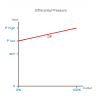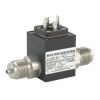This guide provides an overview of methods for measuring liquid density using differential pressure sensors in various tank configurations and conditions.
- Density measurement challenges: Measuring density directly is difficult because it requires simultaneous measurement of mass and volume.
- Density measurement with liquids: Liquid density measurement is easier because liquids take the shape of their container, making it much simpler to measure the volume, as the volume of the liquid becomes the same as the volume of the container it fills.
- Hydrostatic pressure principle: The hydrostatic pressure formula (P = ρgh) is used to determine density. Since gravity (g) and liquid height (h) are fixed, pressure (P) is the only variable quantity needed to calculate density (ρ).
- Differential pressure (DP) sensor methods:
- Fixed liquid level
- Open to atmosphere: If the liquid level is constant but density changes, the high side of the DP sensor is connected to the bottom of the tank, and the low side is left open to atmosphere. This method requires a DP sensor with wide rangeability, and narrow span to measure the small changes in density.
- Reference liquid column: If a high turndown ratio DP sensor isn’t available, a reference liquid column (constant density) is used, allowing for a lower range DP sensor for better accuracy.
- Sealed tank (dry leg): If the tank isn’t open to the atmosphere, a dry leg reference (connected to the top of the tank) compensates for pressure above the liquid surface.
- Varying liquid level
- Varying liquid level (wet leg): If the liquid level changes, the DP sensor is connected to two points below the surface, and a wet leg or remote seal is used on the low side to prevent liquid escaping the tank and causing a calibration shift.
- Fixed liquid level
Density is a difficult quantity to measure directly, since it is necessary to measure the weight and volume of an object simultaneously, since density is equal to mass divided by volume (ρ = m/V). However if the object is a quantity of liquid, then it becomes much easier to measure density. A quantity of liquid will completely fill a given space such as a tank, and the volume will always be the same between two points separated vertically on the tank. If the volume is not changing, then it is only necessary to calculate the changing weight of the fluid within the confines of the fixed volume of liquid between the two vertically separated points on the tank.
The mass of the fluid contained within the fixed volume of fluid can be determined with the help of the hydrostatic pressure formula. The formula states that the pressure of a liquid head is equal to the density multiplied by the acceleration due to gravity and the height of the fluid (P = ρgh). Since gravity and the height of the liquid are also fixed quantities, we are left with the pressure, the only variable parameter required to determine the density of the fluid.
Depending on the type of tank, and the properties of the liquid contents, there are a few different ways of installing a differential pressure sensor to measure density.
If the liquid level is maintained whilst the density of the liquid changes, the pressure of the liquid contents will vary due to the change in mass of fixed volume of liquid. In this case it is possible to only measure the liquid pressure on the high side of the dp sensor, and leave the low side open to atmosphere to compensate out the atmospheric pressure acting on the surface of the liquid. However this requires a DP sensor with good rangeability to achieve a small span with a large elevated zero offset to monitor the relatively small change in density.
If a dp sensor with high turndown ratio is not possible to use, then a reference fixed liquid column with a constant density should be used instead, which will reduce the need to elevate the zero offset and turndown the range, which would otherwise compromise the measurement accuracy. This allows a lower range DP sensor to be used between the tank and the reference liquid column, improving the reading accuracy and resolution for small changes in hydrostatic pressure due to a change in liquid density.
If the tank is sealed off from atmospheric pressure changes, then the pressure of the liquid at the bottom of the tank is now the sum of the liquid contents pressure plus the pressure above the liquid surface, which is now independent of outside air pressure. In this case it is necessary to create a dry leg reference by connecting the low side of the dp sensor to the top of the tank so that the pressure there can be compensated out from the liquid pressure measured on the high side. If there is a risk of condensation forming in the leg, then a wet leg or remote seal should be used to maintain a stable calibration on the low side of the dp sensor.
If it is not possible to maintain a constant liquid level and the liquid level is varying due to emptying and filling of the tank, then the dp sensor must be connected to two points below the surface of the liquid. Both connections must always be submerged to maintain a constant liquid level between the two points. A wet leg or remote seal should be used to connect the low side of the dp sensor, and at a point that is below the minimum liquid level to ensure it is always submerged.
Here are the steps for measuring liquid density using a DP sensor. Please note this assumes a basic understanding of DP sensors and some scenarios may require variations:
- Determine Tank Conditions: Understand if the tank is open to the atmosphere, sealed, and whether the liquid level is constant or varying.
- Select DP Sensor Installation: Based on your tank conditions, choose the appropriate method:
- Open tank, constant level: High side to tank bottom, low side open to atmosphere.
- Open tank, constant level with need for higher accuracy: Use a reference liquid column.
- Sealed tank without risk of liquid evaporation: High side to tank bottom, low side connected to a closed chamber above the liquid (dry leg).
- Sealed tank with risk of liquid evaporation: High side to tank bottom, connect the low side to the top of the tank using a wet leg or a remote seal.
- Install DP Sensor: Mount the DP sensor with connections, taking precautions for wet legs or remote seals if necessary.
- Calculate Hydrostatic Pressure: Measure the differential pressure between the two sensor points.
- Determine Density: Use the hydrostatic pressure formula (P = ρgh) with known values for gravity (g) and liquid height (h) to solve for density (ρ).
Related Help Guides
- Measuring vacuum as a negative gauge pressure using a dp sensor
- How do you measure flow rate with a dp cell
- Measuring liquid level in a tank using a dp sensor
- Measuring the difference in air pressure between rooms
- Measuring negative pressure using a positive differential pressure range
- What can a DP sensor be used to measure beyond differential pressure?
Related Technical Terms
Related Online Tools
- Fluid Depth, Density, Gravity, and Pressure Calculator
- High and Low Side Pressure to Differential Pressure Calculator
- DP Flow Transmitter Output Calculator
- Mass & Volume to Density Calculator
- Mass and Length Total to Linear Density Calculator
- Mass and Area Total to Area Density Calculator
- Mass and Length x Width to Area Density Calculator
- Density Converter
- Linear Mass Density Converter
- Area Density Converter
- Density to Specific Gravity Calculator
- Volume Flow & Density to Mass Flow Calculator
- Mass Flow & Density to Volume Flow Calculator


